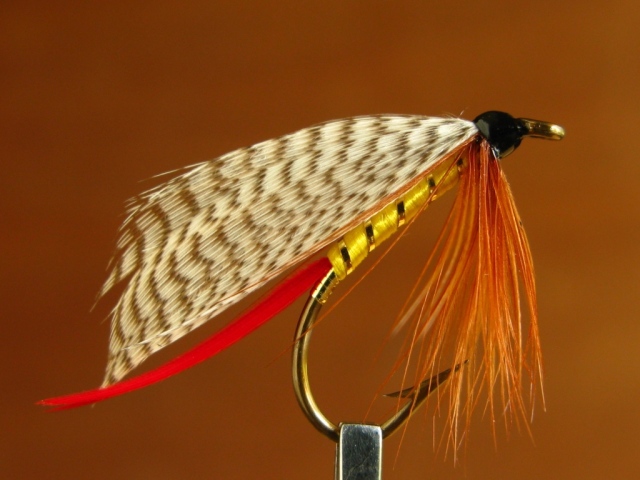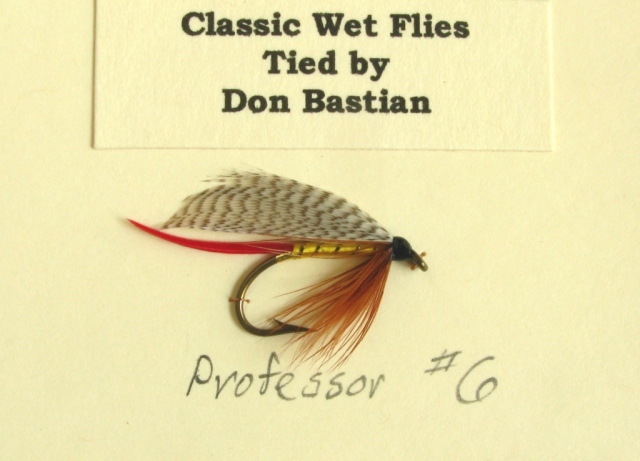I tied a Professor wet fly for a customer this week; he wanted to add it to his fly collection. I took a couple photos of the fly before mailing it. Back in 2006, I wrote an article in Eastern Fly Fishing Magazine on the Professor, including information on the pattern history. The Professor was created in Scotland in 1820, and according to Mary Orvis Marbury’s book, Favorite Flies and Their Histories, 1892, was named for Professor John Wilson, who was also known as Christopher North. Perhaps that was a pen-name. John’s brother, the naturalist, James Wilson, and John are also credited with the creation of the Queen of the Waters.
The Professor went on to secure a place in American fly fishing history, became more popular in America than its country of origin, and is one of a few patterns that was made into just about every other style of fishing fly except for a nymph. Though it would probably be a good fly if the Professor was “nymphed.” A Professor nymph would be similar to the Tellico, though perhaps with the wing case like a Zug-Bug. I can vouch for the effectiveness of both the Tellico Nymph and Zug Bug.
The Professor was traditionally made as a trout wet fly, but it also because popular as a large lake fly, a dry fly, fan-wing dry fly, streamer, and hairwing steelhead pattern.

Professor wet fly, size #6. This wing was tied on in the older style of the 1800’s, at least with regard to the tip and shape of the barb sections. By the 1900’s the popular style among most commercial fly companies was to elevate the tip of the wing quill or flank feather sections to the top side, with the tip pointing up. Dr. Edgar Burke’s wet fly paintings in Ray Bergman’s Trout, Just Fishing, 1932,and With Fly, Plug, and Bait, 1947, are all representative of tip-up wet fly winging. My research over the last eight months on the 1800’s Orvis flies has shown the turned-down tip to be the popular winging style of that time period. In fact the original flies from Marbury’s book, and the flies in the 1893 Orvis display at the American Museum of Fly Fishing in Manchester, Vermont, all exhibit the tip down wing. I’m getting more interested in this because of its historical significance, and maybe I’m even liking it more. It’s not always completely true that people are set in their ways, or that they can’t learn to appreciate different things. This style of winging makes the flies look more “retro,” to use a modern term. Classic, traditional, or historic representations of our heritage wet fly patterns would be a more fitting description.
Professor:
Hook: Standard wet fly hook, size #1 to #12
Thread: Danville #1 White Flymaster for body; #100 Black for head.
Tag: Flat gold tinsel
Tail: Scarlet quill section(s); scarlet ibis was traditionally used for tailing
Ribbing: Flat (oval on 1800’s Orvis patterns) gold tinsel
Body: Yellow floss
Hackle: Brown
Wing: Gray mallard
Head: Black
Fishing With the Fly, 1883, coauthored by Charles F. Orvis and A. Nelson Cheney, lists the Professor as pattern No. 11 on one of the color plates as a Lake Fly Pattern. Lake Flies were traditionally dressed on larger hooks, for brook trout and land locked salmon, that is why I listed hook size above as large as size #1. The Professor Lake Fly dressing is identical to this recipe but also has white slips married into the tail, underneath the scarlet ibis.
Pennsylvania author James “Jim” Bashline, indicates the Professor is a good fly in sizes #2, #4, and #6 in his book, Night Fishing forTrout. I can also vouch for the effectiveness of the Professor as a large night fly. And it just hit me, there really isn’t that much difference between “night flies” and the old “lake flies.” With the exception that night flies were dressed with a focus on brown trout, which according to scientific research on their optic system, have better night vision that other species of the trout family. Brown trout were still living in Europe and the British Isles when American Lake Flies were originated.
My research for the last nine months on the 1800’s Orvis flies, including actual visual inspection of Marbury’s book flies and her 1893 display, (lucky me), indicates most all of the tags on those flies were flat tinsel, and the ribbing was most often oval.
On this wing I used two large, select gray mallard flank feathers, a matched pair forming a left and a right wing using the same method as when cutting equal-width slips when using a matched pair of wing quills. The historic patterns, and all that I have seen size #6 and larger, used tips of whole feathers to make the wings. These were placed bottom, concave sides facing together. Whole feather wings would be especially true on the Lake Flies. The Professor’s companion pattern, the Grizzly King, was also made as a Lake Fly.
The hackle was tied in at the clipped butt section, wound three times, then the barbs were folded down, divided, and wrapped over a few times with tying thread to secure it.

Professor wet fly, mounted and labeled, to be packaged in clear plastic, business card size box, with a separate signature card included. This year I upgraded my packaging of Collector’s Flies. It takes a little more work, but the flies look better. Enhanced appearance makes almost everything look better. I used to insert the hook point into a small square of foam. Now I carefully wire the hook at the eye and bend, and I am also using another section of card stock in back. My display flies are now all double-sided with card stock backing, using acid-free cement.
My plan for the Arts of the Angler Show at the Ethan Allen Inn, Danbury, Connecticut, on November 10 and 11; and The International Fly Tying Symposium in Somerset, New Jersey, November 17 and 18 is to have a big inventory of a wide range of Collector’s Edition wet fly styles in stock. More than usual. At least that’s my plan.
Along with 20th century wet flies, representative of the dressings and patterns in Ray Bergman’s books, I also hope to include new (for me) patterns from Helen Shaw’s book, Flies for Fish and Fishermen: The Wet Flies, 1989; J. Edson Leonard’s 1950 book, Flies, and H. J. Noll’s Guide to Trout Flies and How to Tie Them, 1965. I have been using these resources for some years already, but there are new patterns that I want to include. There is a wealth of additional wet fly patterns in these sources that I have not previously tapped. I also will be presenting many more of the 18th century Lake and Bass Fly patterns, including some previously unpublished patterns I have discovered that are presently unknown. I’ll be including at least thirty previously unpublished 19th century trout and lake flies to my current book, The Favorite Flies of Mary Orvis Marbury.
The flies I recently posted in The Fly Young Knight were dressed in the tip-down style of wings.



























